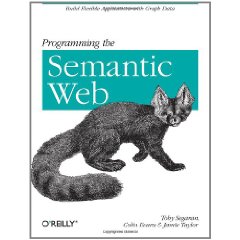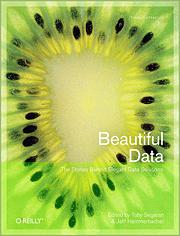As I’ve mentioned previously, I’m a big fan of Toby Segaran‘s book Programming Collective Intelligence. It introduces several cutting-edge algorithms for building intelligent web applications through a well chosen set of compelling example programs . A different author might have made the book a dull, overly mathematical ordeal but Segaran manages to inspire the reader to find ways to apply these exotic techniques in their own projects. I was therefore interested to discover that he has since collaborated on two new books that will both be released in July.
 For Programming the Semantic Web, Segaran has teamed up with Colin Evans and Jamie Taylor. I was unable to find a table of contents for this book but the publisher’s blurb suggests that it will follow the same pragmatic, hands-on formula that worked so well for Programming Collective Intelligence:
For Programming the Semantic Web, Segaran has teamed up with Colin Evans and Jamie Taylor. I was unable to find a table of contents for this book but the publisher’s blurb suggests that it will follow the same pragmatic, hands-on formula that worked so well for Programming Collective Intelligence:
With this book, the promise of the Semantic Web — in which machines can find, share, and combine data on the Web — is not just a technical possibility, but a practical reality. Programming the Semantic Web demonstrates several ways to implement semantic web applications, using existing and emerging standards and technologies. With this book, you will learn how to incorporate existing data sources into semantically aware applications and publish rich semantic data.
Programming the Semantic Web will help you:
- Learn how the semantic web allows new and unexpected uses of data to emerge
- Understand how semantic technologies promote data portability with a simple, abstract model for knowledge representation
- Be familiar with semantic standards, such as the Resource Description Framework (RDF) and the Web Ontology Language (OWL)
- Make use of semantic programming techniques to both enrich and simplify current web applications
- Learn how to incorporate existing data sources into semantically aware applications
Each chapter walks you through a single piece of semantic technology, and explains how you can use it to solve real problems. Whether you’re writing a simple “mashup” or a maintaining a high-performance enterprise solution, this book provides a standard, flexible approach for integrating and future-proofing systems and data.
 Toby has clearly been keeping himself busy because he’s also found time to co-edit the latest installment in O’Reilly’s Beautiful Code series. In 2007 the original Beautiful Code book presented an eclectic mix of 33 essays about elegance in software design and implementation, each written by a different well-known programmer. The success of this anthology has resulted in O’Reilly issuing three companion volumes in 2009: Beautiful Architecture, Beautiful Security and the forthcoming Beautiful Data: The Stories Behind Elegant Data Solutions (edited by Toby Segaran and Jeff Hammerbacher).
Toby has clearly been keeping himself busy because he’s also found time to co-edit the latest installment in O’Reilly’s Beautiful Code series. In 2007 the original Beautiful Code book presented an eclectic mix of 33 essays about elegance in software design and implementation, each written by a different well-known programmer. The success of this anthology has resulted in O’Reilly issuing three companion volumes in 2009: Beautiful Architecture, Beautiful Security and the forthcoming Beautiful Data: The Stories Behind Elegant Data Solutions (edited by Toby Segaran and Jeff Hammerbacher).
Beautiful Data follows the same format as the other books in the series, with each chapter authored by different expert practitioners. One of these chapters covers the making of the video for Radiohead’s House of Cards single, while another is about data processing challenges faced by NASA’s Mars exploration program.
Clearly I haven’t read either of these books because they are not available yet, so I can’t make any informed recommendations, but they do both look like they could be interesting.